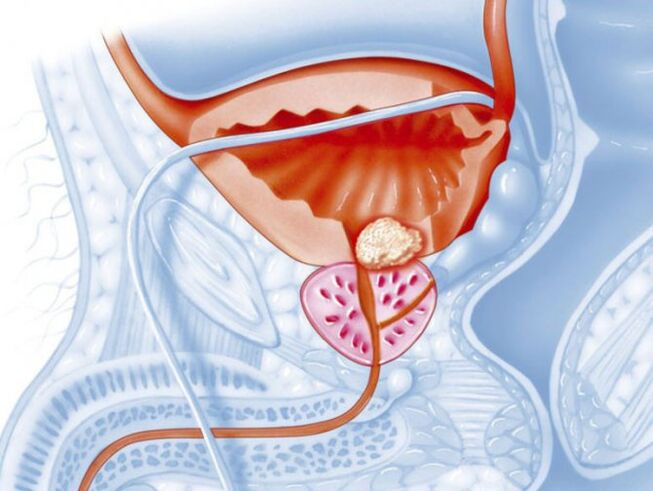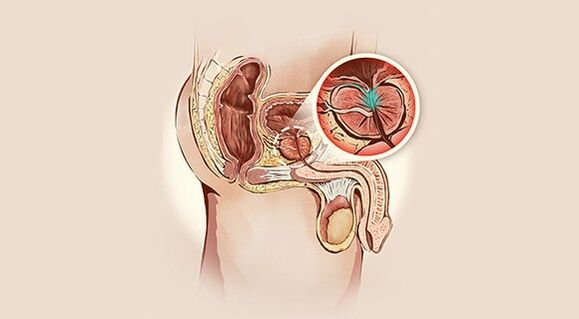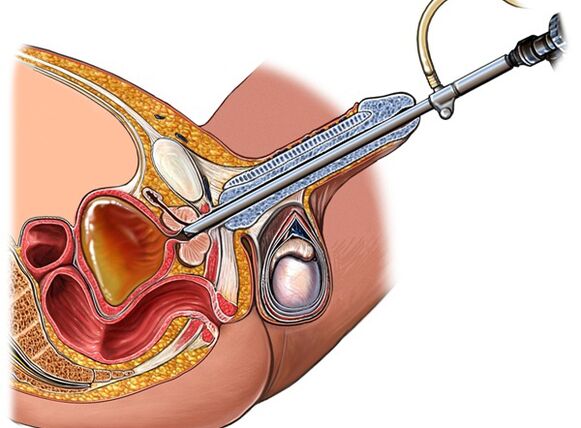Prostate disease is one of the most common and insidious diseases in men over 40 years. At first, patients do not know that there is a problem, but over time, the symptoms become noticeable. If you do not consult a doctor in time, prostatitis becomes chronic and complications can occur. Different types of prostatitis are distinguished depending on the severity, causes and nature of the course.
Types of prostatitis according to the form of the course:
- sharp;
- chronic;
- secret
What is prostatitis due to its occurrence:
- herpetic;
- bacterial;
- accountable;
- stagnant;
- contagious;
- purulent;
- chlamydia;
- mushrooms;
- gonorrhea;
- fibrous.
Classification
Many men who suffer from such an unpleasant disease of the genitourinary system as inflammation of the prostate gland wonder why they get prostatitis.
Understanding the etiology of the disease helps in accurate diagnosis and effective prevention.
With flow form
According to the form of the course, prostatitis is divided into acute, chronic and latent, among which are catarrhal, follicular, parenchymal (purulent).
There are the following forms of the disease:
- In men with catarrhal prostatitis, there is urination and discomfort in the groin area. This is the most common type of acute prostatitis.
- Follicular prostatitis is characterized by symptoms such as pain, fever and severe urination (dysuria) in the groin or anus. In a more advanced form, when the patient delays a visit to the doctor, severe pain occurs during urination and urinary retention occurs.
- Parenchymal prostatitis - a purulent abscess in the body of the prostate gland. In this case, there is a fever, often with sharp pains with the desire to urinate. The temperature rises to 39-40 ° C, defecation is almost impossible.
Acute prostatitis
Acute prostatitis is a condition in which there is inflammation of the prostate gland that occurs over a short period of time and is characterized by various symptoms. Swelling of the pancreas occurs, provoked by the negative effects of pathogenic microflora. Bacteria that cause the disease disrupt the integrity of the tissues, causing permanent discomfort in the pelvic region, even at rest.
There are several preferred ways for the infection to enter the prostate gland:
- with inflammation of the rectum - lymphogenic way;
- after infectious diseases - hematogenous;
- directly from the urethra - canalicular.
Excessive accumulation in the prostate gland creates excellent conditions for the growth of bacteria, which leads to various complications:
- abscess;
- BPH;
- prostate cancer;
- power loss;
- infertility.
The symptoms of prostatitis are so painful that the patient immediately seeks help from a doctor. If you do not do this in time, prostatitis will turn into a chronic form and is very difficult to treat. Antibiotic treatment, along with drugs that strengthen the immune system, effectively fights the disease.
Chronic prostatitis
Symptoms of chronic prostatitis usually appear against the background of obstruction of the prostate gland and occur as a result of an acute untreated disease. It usually occurs in men over the age of 50 who do not seek help and self-medicate. Complications have occurred in many due to concomitant diseases. In addition, not everyone at this age is sexually active enough, resulting in thickening and stagnation in the occult prostate, which leads to dysfunction. Loss of family ties also causes fluid retention. According to modern research, about 40% of people with symptoms of chronic prostatitis have an erection problem.
Chronic prostatitis, as a rule, has only mild symptoms that occur during exacerbation. Patients experience increasing dull pain in the groin area after physical exertion and at the end of the day. Often the pain spreads to the spine, scrotum and perineum. Urination is often noted, especially at night, when the flow is intermittent and crooked.
Sexual intercourse is shortened, an incomplete erection is noted, and sometimes there is pain in the penis. Infertility is common in patients with chronic prostatitis; Impotence is practically absent at this stage of the disease. Sometimes there is a change in the color of the genitals, it turns purple due to improper blood circulation.
Each of the symptoms of prostatitis gets worse if left untreated. The situation is similar to the manifestations of the acute course of the disease. Weakening of the immune system, stress, indifference to diet, bad habits - all this leads to aggravation and worsening of the situation.
Often, the chronic form causes symptoms such as cystitis, kidney disease and adenoma. The risk of developing urolithiasis and a malignant tumor increases. Often the pathological process is almost asymptomatic and is detected accidentally during laboratory tests associated with another disease.
Due to the occurrence
There are many causes and predisposing factors that lead to the development of prostatitis of infectious and non-infectious etiology. The following types of prostatitis differ in their occurrence:
- bacterial;
- accountable;
- stagnant;
- contagious;
- purulent
A sedentary lifestyle, frequent hypothermia, infrequent sexual activity, interrupted sex, smoking, alcohol abuse, stressful situations - all this affects the stagnation of secretion in the vessels of the prostate gland and adjacent vessels. Prostatitis is classified into several forms depending on the cause.
Bacterial prostatitis
Bacterial prostatitis is caused by bacteria that enter the prostate gland in different ways. It can be either a type of bacteria or a group. The disease can be caused by:
- mushrooms;
- gonococci;
- Kochun's stick;
- chlamydia;
- several types of bacteria at the same time.
The inflammatory process is most often associated with the penetration of bacteria into the prostate gland, which is caused by sexually transmitted diseases. Frequent change of partners and the use of sexually transmitted diseases without the use of contraceptives can lead to diseases such as gonorrhea, chlamydia, fungal infections. In addition, the development of pathology is facilitated by a decrease in immunity due to a violation of work and rest. Smoking, alcohol consumption, sedentary lifestyle, etc. As bad habits also reduce immunity.

The most common symptoms that accompany bacterial prostatitis include burning, pain, and cloudy discharge during urination. The smell of urine is unpleasant. Common symptoms that accompany intoxication are: dizziness, weakness, nausea, fever. Pain is noted during ejaculation and sometimes blood is present. With chronic bacterial prostatitis, urination is faster, with a yellowish or green discharge from the penis.
Calcified prostatitis
With significant prostatitis, stones form in the ducts of the prostate gland. This form of the disease is very complicated and is accompanied by severe pain. Conglomerates are of various origins: calcium and protein-dominated phosphates, oxalates.
There are two reasons for the formation of stones in the ducts: stagnation in the gland and urination of the prostate.
Stagnation is associated with various factors that impede the normal flow of secreted fluid. Prolonged sexual abstinence, hyperplasia, the presence of a tumor that closes the ducts, and a sedentary lifestyle lead to stagnation of secretions and disruption of the vascular and lymphatic systems.

Urination is triggered by a malfunction of the sphincter, which relaxes and the urine flows both outside and inside. The presence of stones and sand in the bladder promotes the development of stones in the prostate ducts. They enter with urine, settle down and continue to grow, and as a result reduce their output. Genital injuries and surgical interventions can cause sphincter dysfunction.
Initially, the calcified form of prostatitis is asymptomatic, and as the stones grow, the symptoms appear and increase. There is pain in the lower abdomen or scrotum that spreads to the thighs and lower back. No pain is observed at rest and occurs only during physical exertion, defecation and urination, as well as during sexual intercourse and walking.
During their movement, large stones with sharp edges damage the canal, which causes not only pain, but also bleeding and discharge in the urine. Stone sores can be easily infected and then calcified prostatitis becomes contagious.
After about a month, with calculus prostatitis, the whole body is disturbed, the person feels unwell, insomnia, fatigue and irritability increase.
In the advanced stages of calcified prostatitis, a drug is prescribed after a complete diagnostic examination and surgical treatment is performed to remove the conglomerates.
Congestive prostatitis
The stagnant appearance of prostatitis occurs due to delayed secretion in the prostate gland. Such problems are more common in men who are sedentary and do not exercise. As a result of hypodynamics, blood circulation in the pelvic organs is disrupted, the prostate is not adequately supplied with oxygen and nutrients, stagnation and inflammation occur. If nothing is done, the disease becomes chronic and causes great anxiety.
Congestive prostatitis provokes irregular sex life or no sex at all. In this case, men should release the glands independently of the secretion, but do not overdo it, because regular masturbation can cause damage due to incomplete ejaculation. Many spouses have found for themselves a way to prevent pregnancy as a disconnected relationship. It also causes incomplete discharge and inflammation.

Sometimes hypothermia or varicose veins become a trigger. Abnormalities in the structure of the prostate gland can also cause stagnation. Regular warming of the pelvic region and persistent constipation adversely affect the production of secretions. Depending on the factors that cause the disease, several types of congestive prostatitis differ.
- Venous prostatitis. Occurs in people with varicose veins of the lower extremities. In this disease, all the organs in the small pelvis are affected due to improper blood circulation.
- Traffic jam. It develops with partial emptying of the prostate gland. Gradual overflow leads to stagnation.
- Chronic. The wrong lifestyle develops when it becomes a habit. If nothing is done to change the condition, the disease becomes chronic. This is more common in single men suffering from obesity, already in adulthood, with a history of co-morbidities. At this stage, the prostate often grows, which is easy to identify during the examination.
- Infectious. When the infection enters the genitourinary system, it joins the already existing inflammation of the prostate.
Symptoms of prostatitis include difficulty urinating, pain in the abdomen, tension during bowel movements, and decreased sexual activity. As a result of these symptoms, stagnant prostatitis develops poor health, irritability, decreased ability to work and sleep disorders.
Infectious prostatitis
Microorganisms that can cause symptoms of acute prostatitis include Escherichia coli, Staphylococcus aureus, Proteus, Eltirococcus, Klebsiella. There are bacteria that are constantly present in the body, but they do not cause inflammatory processes when inactive. When it penetrates the mucous membrane of the prostate gland through the urethra, the process of development and reproduction of microorganisms that develop inflammation begins. Non-discriminatory and unprotected sex also allows harmful bacteria to enter the body.
Typical symptoms are pain in the scrotum, perineum, lower abdomen, back, and a small pelvis. Urinary incontinence, acute urinary retention occurs. In addition to the listed symptoms that accompany an infectious type of prostatitis, constipation, urethral discharge, hemospermia, and pain during ejaculation may occur.
It is a dangerous disease that can cause infection of a sexual partner, even in the earliest stages, leading to general blood poisoning or the development of pyelonephritis and cystitis.
Purulent prostatitis
Eruptive prostatitis usually develops when a bacterial infection enters the prostate. The disease occurs in four stages.
- Catarrhal. It develops after suffering from acute respiratory viral infections, tonsillitis, influenza. There is a purulent content in the urine. There is a burning sensation when the bladder is empty. Patients report impaired potency. The process that accompanies this type of prostatitis involves the surface tissues of the prostate.
- Focus. The process extends to the glandular tissue. The canals swell, the flow is disturbed. The gland increases in size due to the accumulation of pus excreted in the urine. Body temperature rises.
- Parenchymal. Connective tissue is involved in the process, the edema grows further, the temperature can reach 40 ° C. Bursting pain in the anus, the desire to ejaculate.
- More than enough. The most insidious form of prostatitis. The heat is severely mixed, there is a lot of pus and unbearable pain. This stage can be complicated by peritonitis and is fatal.
The eruption can be complicated by symptoms and diseases such as prostatitis, paraproctitis, paracystitis, abscesses, sepsis. Generally, these pathologies are treated surgically and involve the removal of purulent sacs.
Diagnostics
Diagnosis of prostatitis is not particularly difficult, and begins with the collection of anamnesis, which helps to better understand the picture of the disease. Then a rectal examination is performed, during which the size of the gland is determined, the nature of the pain is determined, the presence of edema and seals is detected.
Laboratory tests are scheduled to make a correct diagnosis:
- Urine analysis;
- Urine culture with EU sensitivity test;
- general blood test;
- analysis of prostate secretion;
- blood chemistry;
- rectal examination.
Additional diagnostics include instrumental research methods. First of all, an ultrasound is performed, and if necessary, additional MRI and TRUS are prescribed. Relatively recently, a new method of PET examination has emerged, which is considered the most informative.
Treat inflammation
Urologists treat all types of prostatitis. Traditional methods are good, but only with medical prescriptions and with the permission of the attending physician.
You must first find out the cause of the disease, and only then can you carry out symptomatic treatment.
- Active antibiotic therapy helps treat prostatitis. Parenteral antibiotics are the most effective.
- Painkillers and diuretics are indicated for an obvious pain syndrome.
- Laxatives are prescribed for constipation.
- Novocaine blockade is used with severe pain and difficulty urinating.
- The course of vitamin therapy and immunocorrectors is indicated.
- It is worth following a special diet that excludes spicy, salty, smoked foods.
- Bed rest is scheduled.
From local procedures, sitz baths with water, the temperature of which is two degrees higher than body temperature, are indicated. Enemas are prepared with vegetable oil of anti-inflammatory herbs with the addition of 1% anesthetic, the substances in it are slowly injected into the intestines and remain there for as long as the patient can tolerate.
Physiotherapy treatment also has a beneficial effect on the restoration of prostate function. Prostate massage is contraindicated in acute prostatitis, but is recommended in chronic form. UHF and microwave ovens are prescribed to restore metabolism, restore normal blood circulation and reduce edema.
A catheter is inserted with prolonged urinary retention. At some stages of the disease, surgical treatment is indicated to open the purulent sacs with the installation of drainage.
Treatment of acute prostatitis lasts from several weeks to a month. A favorable result is generally observed. If the disease becomes more complicated or becomes chronic, the process will be difficult, long and can take several months.
Restriction of sexual activity and use of personal protective equipment are indicated during treatment.
Medical physiotherapy helps to treat prostatitis. Effectively eliminates the symptoms of prostatitis, can restore reduced sexual activity, reduce pain, eliminate swelling and inflammation. The device can be used at home for both treatment and prevention of pelvic diseases.
The device will relieve muscle tension, improve sperm production, strengthen blood vessels and prevent the development of other possible diseases of the small pelvis. The device, which treats prostatitis in men, is easy to use, equipped with a regulator of heat and vibration regimes, and equipped with a network. The compact size allows the device to be used in any conditions.
How to prevent the development of the disease?
Prevention of various types of prostatitis, like other diseases, is a healthy lifestyle, bad habits and a balanced diet. If you have been diagnosed with prostatitis, exercise should not be neglected. For any nidus inflammation that occurs, you should see a doctor immediately to eliminate the cause and prevent the infection from entering other organs.

You should lead a good lifestyle and have regular sex with a regular partner. It is important to remember the personal hygiene of the genitals and not to neglect regular preventive examinations by a urologist. If a man knows what prostatitis can be and at the same time leads a passive lifestyle, actions should be taken to prevent blockage in the small pelvis.
Let's summarize
Depending on the causes and characteristics of the course, acute and chronic forms of prostatitis are diagnosed. Chronic pelvic pain syndrome belongs to a separate group. Acute prostatitis is characterized by clinical manifestations such as chills, fever and pain. The chronic form may not manifest itself in any way or may have a mild appearance: impaired urinary excretion, excruciating pain in the pelvic region, leading to impotence and loss of fertility as complications develop.

Acute prostatitis develops suddenly and is easily diagnosed. In contrast, chronic prostatitis continues with waves, with periods of remission and exacerbation changing. Detection of pathogenic microbes in a chronic course can cause certain difficulties. Outbreaks appear to be exacerbated during pregnancy and in patients with defective genitourinary tract infections. Depending on which prostatitis is diagnosed, the urologist prescribes a differential treatment regimen.






























